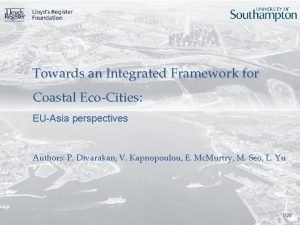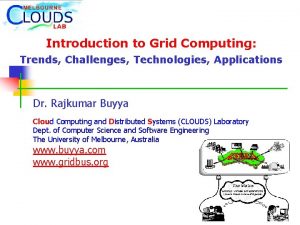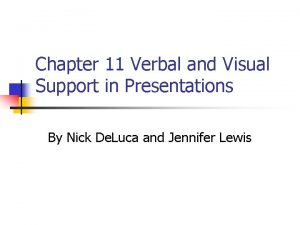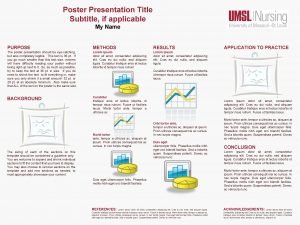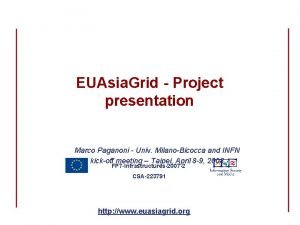EUAsia GRID Community Presentation Title and Applications Support













- Slides: 13

EUAsia. GRID Community Presentation Title and Applications Support Speaker Institution Jan Kmuníček, CESNET Event Name 1

Content • EUAsia. GRID consortium • Grids in South-Asia region – communities description – resources available – user support tools • Incorporation into EGI model 2

EUAsia. GRID consortium • Partners from the South-Asia region – Philippines, Australia, Taiwan, Singapore – Thailand, Vietnam, Indonesia, Malaysia • Project itself not building Grid infrastructure – coordination action of separate local efforts • Organization of application support crucial – does not built on any already established structure • South-Asia interoperability with EGI is the key – installation of g. Lite sites – uptake of established EGEE tools and solutions 3

Asia region specifics • Already existing Grids within the region – Globus based solutions – desktop Grids – no mature development in other areas (g. Lite, …) • Not hierarchically strictly monitored model – except the HEP community – preferably flat model of involved communities 4

Community • What types of people are involved in community? – scientists (end-users), application developers • Description of community – interdisciplinary, international – suffering from complexity, gaining from diversity • How does that affect your expectations for EGI? – urgent need for extremely light-weight procedure how to establish a VO – easy way how to utilize RESPECT-like recommended tools and instruments 5

Community • Are there strong, central international centers of gravity within your community? – very well organized and established HEP community • How do you see the relationship between your community and Virtual Organizations? – one VO-many communities – majority of communities project-based • What VO lifecycle to you expect for the VOs in your community? – long-lived central regional catch-all VO 6

Application domains • First runners – HEP, Biomedical & bioinformatics – Computational chemistry, Social science – Disaster mitigation • Newly identified – Cultural heritage • Potential adopters – Biodiversity, Financial – Mathematics, Operational research – Natural language processing 7

Resources • How is computing within community generally funded? – each partner has its own funding, project serves for coordination purposes • What resources (human and computing) are currently provided by and/or for your community? – Implementation Status, Plans and Requirements (SPRs) • Are the computing resources controlled directly by community? – yes, directly by them 8

Resources • Are they shared with other people/communities or solely for the use of your community? – currently planned for community – could be potentially be made available for others • Are there resources "outside" the grid necessary to work in your community? – if yes, not identified so far • How do those resources impact how you interact/use the grid infrastructure? – has to be evaluated after their identification 9

Support services • What (grid) support services are currently used by your community? – VO management tools (CIC portal, VOMS admin) • Which of those services do you expect to continue in EGI? – hopefully all of them • What support service are not provided now but needed in EGI? – ticketing clearing system (GGUS) – collaborative environments and tools 10

Support services • What types of actors within your community use each type of service? – end users, projects/NGI-like representatives • Who (community itself, national body, national projects, European projects, grid infrastructure, etc. ) do you expect to provide/pay for each of the needed services? – global one by EGI, rest by national bodies • What types of funding does the community need? – travel funds, funds for interfaces/tools development 11

Interaction with EGI • How do you see your community relating to the described SSC model (becomes an SSC, is member of larger SSC, is many SSCs, can not see community in SSC model, etc. )? – application organized around VO – many SSCc foreseen • What types of feedback do you expect to give to the infrastructure (concerning operations, middleware, support, policies, etc. )? – evaluation of global helpdesk, interfaces 12

Interaction with EGI • How do you expect that feedback to be taken into account and on what timeframe? – through User Community Services channels • To whom (or what level) do you expect to give that feedback to (policy boards, advisory boards, community level, national level, EGI level, etc. )? – national, community and EGI levels 13
 Source euasia
Source euasia Pin grid array
Pin grid array Challenges of grid computing
Challenges of grid computing Completing reports and proposals
Completing reports and proposals Signal words example
Signal words example Title title
Title title Types of verbal support
Types of verbal support Smart grid presentation
Smart grid presentation Occipital brow presentation
Occipital brow presentation Leopold maneuver
Leopold maneuver Poster presentation title
Poster presentation title Insert the sub title of your presentation
Insert the sub title of your presentation This is your presentation title
This is your presentation title This is your presentation title
This is your presentation title
